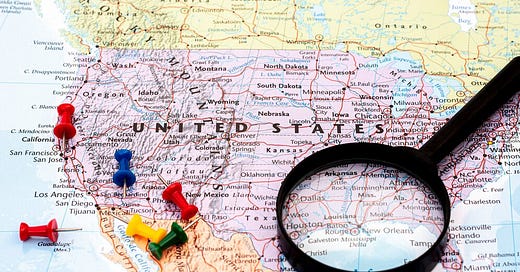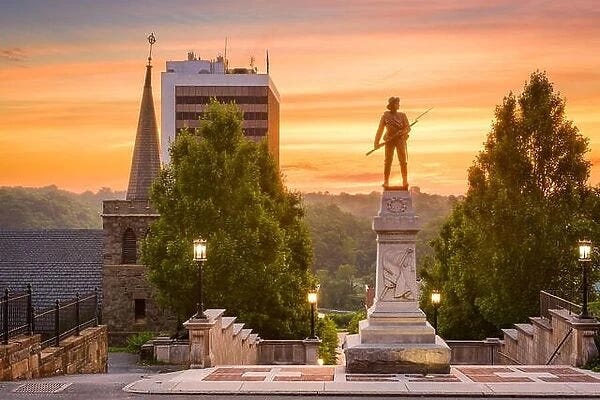Preparing to Leave My Blue City Bubble: The Three Cities
Part Four of Blue City Warrior Visits Red America In Search of Us
This is the fourth part of my series Blue City Warrior Visits Red America: In Search of Us. Go HERE to read the Blue City Warrior opening essay. Please subscribe to follow my journey!
I shouldn’t exaggerate too much. Yes, I live in a blue bubble, and yes, this Blue City Warrior project is driven by my desire to get out of my blue bubble and experience red spaces. But I also need to acknowledge to you readers that this whole project is also driven by my love of exploring new cities, period. The added bonus is that I might even learn a thing or two about red America and red Americans, find a shared humanity, and even grow in my understanding of myself.
The Three Cities
Much of the political and social analysis of the growing divisions in our country use the red-blue divide interchangeably with the urban-rural divide. And while the numbers that I shared in my last post about how dense, urban counties are increasingly blue compared to rural counties, the fact remains that there are urban places that vote red. But how was I going to decide where to go?
In the end, I looked for cities that are reputationally conservative; represented by Republicans up and down their ballot at the city, county, state, and congressional level; have a significant conservative cultural driver; and that might challenge my assumptions about red Americans. Also, fundamentally, I want to visit places that have many of the characteristics of what makes a city great, with interesting histories and are full of spots to explore.
Using this lens, I settled on three cities to visit: Tulsa, Oklahoma; Lynchburg, Virginia; and The Villages, Florida.
Tulsa, Oklahoma
Tulsa, Oklahoma is a traditionally conservative city in a traditionally conservative state. With the exception of voting for Democrat Lyndon B. Johnson in his blow out election of 1964, Oklahoma has voted Republican in all presidential elections since 1952. Tulsa is located where it is because of the oil fields that gave it the moniker “the Oil Capital of the World”. Oil has driven its economy so thoroughly that two of its main tourist attractions are based on fossil fuel. First is the Golden Driller – a 75-foot-tall, 43,500-pound statue depicting an oil worker that started life in 1952 as a temporary feature of the International Petroleum Exposition in Texas. It is now the official Oklahoma State Monument, and is located in Tulsa.
The second fossil fuel-based attraction in Tulsa is a portion of Route 66 – the historic “from Chicago to LA” road. It is still celebrated in Tulsa because it was home to the highway’s founder, Cyrus Avery. Avery made sure “America’s Main Street” ran through town.
I’m also intrigued with Tulsa for three other reasons: one, it’s similar in size to my hometown of Minneapolis (just over 400K residents according to the 2020 Census), but with a very different history and political culture; two, it is also located in Indian Territory where 87 tribal nations were forced to relocate in the 1800s and remains a center of Indian Country; and three, its history with the destruction of Black Wall Street in the 1921 Tulsa Race Massacre.
I will be visiting Tulsa first, at the end of May-early June to coincide with the anniversary of the race massacre.
Lynchburg, Virginia
The next city on my list is Lynchburg, Virginia. Lynchburg made the list because it is home to Liberty University, the private evangelical Christian university of Jerry Falwell Moral Majority fame. Often called the “Bastion of the Christian Right”, Liberty aims to “train champions for Christ”, and is associated with the very theologically and socially conservative Southern Baptist Conservatives of Virginia (Southern Baptist Convention). Generally, as you can imagine, not the kinds of Christians I run into in my South Minneapolis blue bubble.
I’m also intrigued by Lynchburg’s history. It was founded in 1757, and first settled when slavery was the dominant economic model. While it was not captured by the Union Army in the Civil War, it was in proximity to Civil War battles. It is only a half hour’s drive from Appomattox Court House where Confederate General Robert E. Lee surrendered to Ulysses S. Grant's Union forces on April 9, 1865, ending the war. In my blue city upbringing, I have not spent any significant time in that part of the country, and am super intrigued by how it feels to walk the streets that are so seeped in this Southern – nay, American – history. I also expect to partake in some of the attractions that are publicized on the Lynchburg tourism site: nearby hikes, kayaking on the James River, historical walking tours, craft breweries, and hopefully, a Liberty University Flames football game.
The Villages, Florida
The final destination on my tour of red cities is The Villages in Central Florida. For those who have not heard of The Villages, it is a planned retirement community started in the 1970s for those 55+. A reporter once called it “Disney for Boomers.” According to the 2020 Census, there are almost 80,000 people living in The Villages, of whom 86% are over 65, 97.4 percent are white, only 5.6 percent are foreign born, with 11 percent in the labor force (meaning 89 percent are retired). That is to say that the population of The Villages is not reflective of the rest of America, but it is more reflective of Donald Trump’s MAGA voting base. This is evident in the photos I’ve seen from the fall of 2020 with TRUMP 2020-decorated golf carts on parade.
OK OK, I understand that The Villages might not be considered a city in the conventional sense. In fact it is not governed by an elected mayor and city council, but a management company of the “spaghetti bowl of LLC’s” as a reporter described it. It will be different from Tulsa and Lynchburg in that it was not developed under white supremacist and Jim Crow laws, or historic (overt) segregated housing policies. Yet, I anticipate that its development pattern will also reflect our country’s history of racism.
For a Blue City Warrior born in the final year of the Boomer Generation, who fancies herself an active senior looking to experience a red community, I can’t imagine a better place to visit. I hope to visit at the end of October, close to the election, when the partisan divide will be at its highest.
These three red places provide some variety to the conservative base: Tulsa with its more traditional economic conservatism based on the area’s access to natural resources; Lynchburg as a key national center of the Christian Right’s political power as the home to Jerry Falwell’s Liberty University; and finally, The Villages, a unique place dominated by believers in the current Republican Party leadership.
Subscribe to follow my journey!








Interesting, appropriate, and brave choices, Cara. Can't wait to read what you learn.